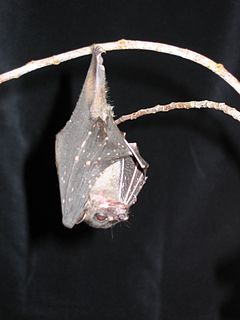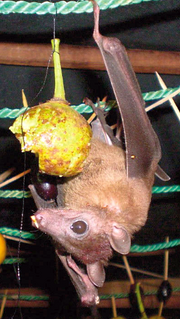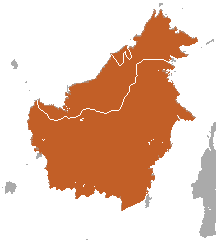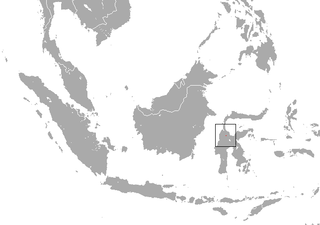
Megabats constitute the family Pteropodidae of the order Chiroptera (bats). They are also called fruit bats, Old World fruit bats, or—especially the genera Acerodon and Pteropus—flying foxes. They are the only member of the superfamily Pteropodoidea, which is one of two superfamilies in the suborder Yinpterochiroptera. Internal divisions of Pteropodidae have varied since subfamilies were first proposed in 1917. From three subfamilies in the 1917 classification, six are now recognized, along with various tribes. As of 2018, 197 species of megabat had been described.

Rousettus is a genus of Old World fruit bats or megabats, referred to as rousette bats. The genus is a member of the family Pteropodidae. The genus consists of seven species that range over most of Africa to southeast Asia, and the islands of the south Pacific. They are among the few megabats capable of echolocation, and the only genus of megabats known to use vocal echolocation.

The Egyptian fruit bat or Egyptian rousette is a species of megabat that is found in Africa, the Middle East, the Mediterranean, and the Indian subcontinent. It is one of three Rousettus species with an African-Malagasy range, though the only species of its genus found on continental Africa. The common ancestor of the three species colonized the region in the late Pliocene or early Pleistocene. The species is traditionally divided into six subspecies. It is considered a medium-sized megabat, with adults weighing 80–170 g (2.8–6.0 oz) and possessing wingspans of approximately 60 cm (24 in). Individuals are dark brown or grayish brown, with their undersides paler than their backs.

The spotted-winged fruit bat, is the smallest megabat in the world, and the only species in the genus Balionycteris. It inhabits forests in Indonesia and Malaysia.

Geoffroy's rousette is a species of megabat or Old World fruit bats. It is one of ten species in the genus Rousettus.

Leschenault's rousette is a species of fruit bat. The scientific name of the species was first published by Desmarest in 1820.

The lesser false vampire bat is a bat found in South Asia and Southeast Asia from Sri Lanka and India in the west to Indonesia and the Philippines in the east. They live in caves and tree hollows. They are insectivorous.
Aethalops is a genus of megabats in the family Pteropodidae. It contains two species:

The Rajah spiny rat also known as the brown spiny rat is endemic to Thailand and Malaysia, Sumatra, Borneo, and adjacent islands.

The edible-nest swiftlet, also known as the white-nest swiftlet, is a small bird of the swift family which is found in South-East Asia. Its opaque and whitish bird nest is made exclusively of solidified saliva and is the main ingredient of bird's nest soup, a delicacy of Chinese cuisine.

Prevost's squirrel or Asian tri-colored squirrel is a colourful species of rodent in the family Sciuridae. It is found in forests in the Thai-Malay Peninsula, Sumatra, Borneo and nearby smaller islands, with an introduced population in northern Sulawesi. Although the Prevost's squirrel is declining in some regions because of habitat loss and hunting, the species is not considered threatened since it generally remains common and widespread. It can live in somewhat disturbed habitats and often visits plantations or gardens. It mostly feeds on plant material, especially fruits, but also takes insects.

The Angolan fruit bat, Angolan rousette or Silky bat is a species of megabat in the family Pteropodidae. It is found in Angola, Burundi, Cameroon, Central African Republic, Republic of Congo, Democratic Republic of Congo, Kenya, Nigeria, Rwanda, Sudan, Tanzania, Uganda, and Zambia. Its natural habitats are subtropical or tropical moist lowland forest, moist savanna, and rocky areas.

The Sulawesi rousette or Sulawesi fruit bat is a species of megabat in the family Pteropodidae endemic to Sulawesi, an island in Indonesia. It is presently the only member of the genus Pilonycteris.

The long-haired fruit bat, also known as the long-haired rousette, is a species of megabat in the family Pteropodidae. It is the only member of the genus Stenonycteris. It was formerly classified in the genus Rousettus until a 2013 phylogenetic study found it to belong to its own genus and tribe.

The Madagascan rousette or Madagascar rousette, is a species of megabat in the family Pteropodidae endemic to Madagascar. Its natural habitat is subtropical or tropical dry forests.

The Bornean treepie is a passerine bird belonging to the treepies genus, Dendrocitta, of in the crow family, Corvidae. It is endemic to the island of Borneo. It is sometimes treated as a subspecies of the Sumatran treepie.

The greater nectar bat or greater dawn bat is a species of megabat within the genus Eonycteris. It is found in Brunei, Indonesia, Malaysia, and the Philippines. Its range is limited and includes Luzon to Maripipi in the Philippines and scattered parts of Borneo including Tuaran and Ranau in Sabah; Bau, Kuching and Bintulu in Sarawak.

The Linduan rousette is a species of megabat in the Rousettus genus of the family Pteropodidae. It is endemic to Indonesia and is known only from four specimens collected in the swamp forest of Lore Lindu National Park, in central Sulawesi. It was first described in 2003.


















